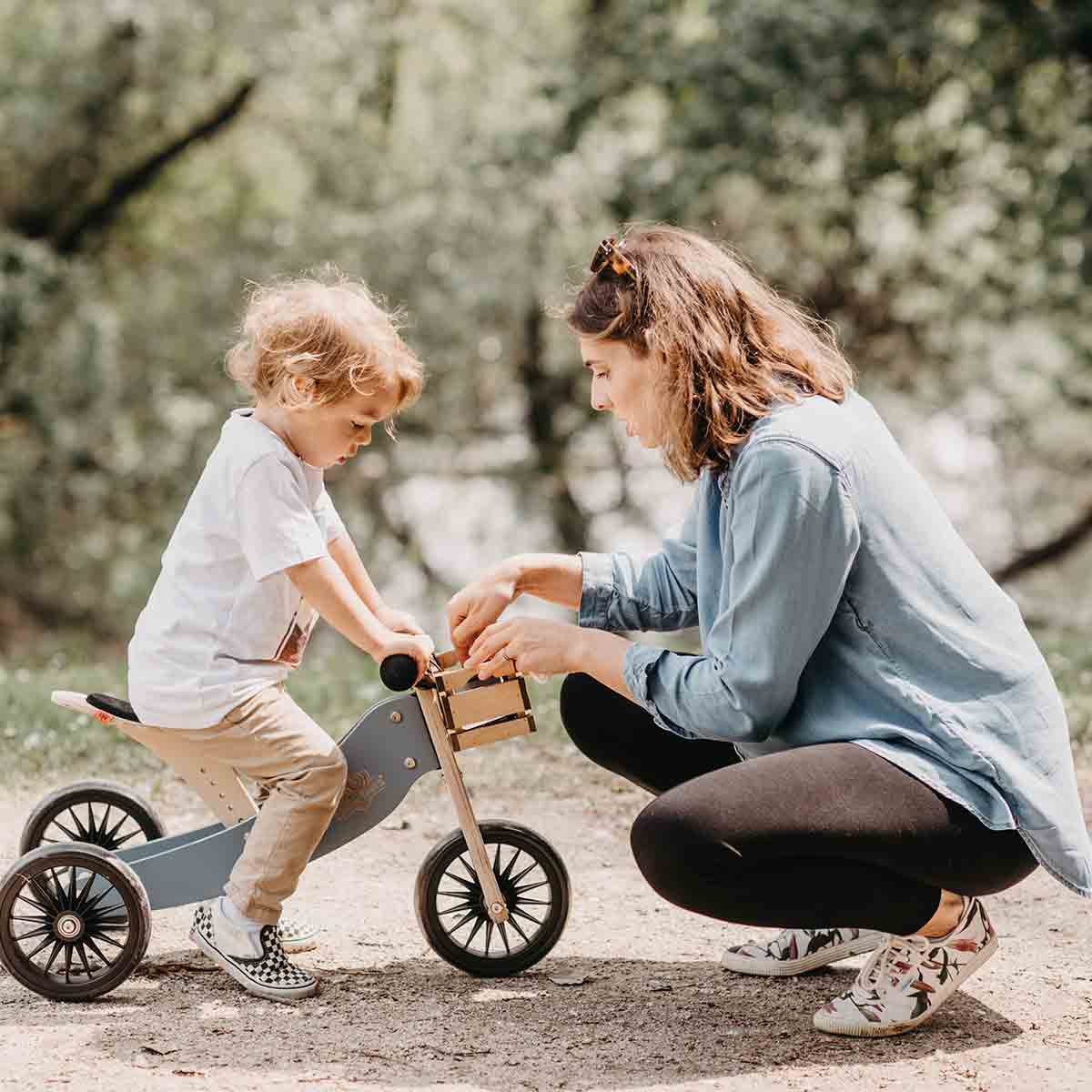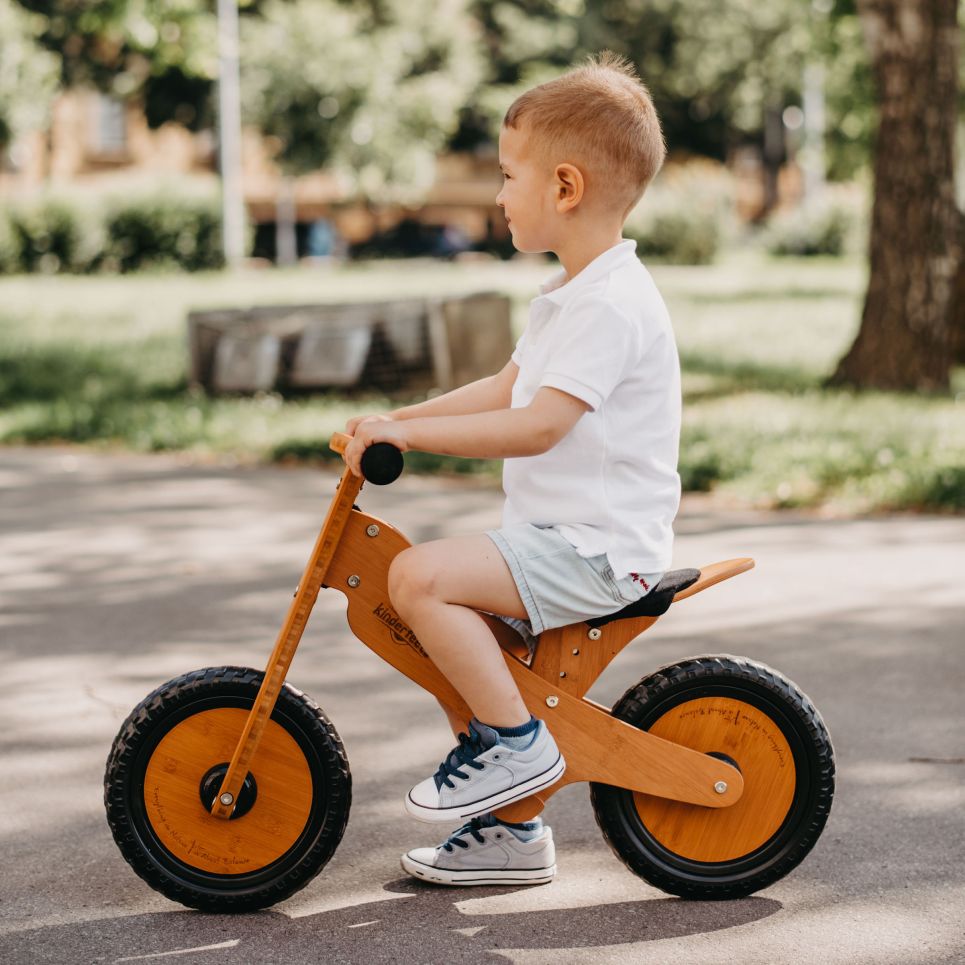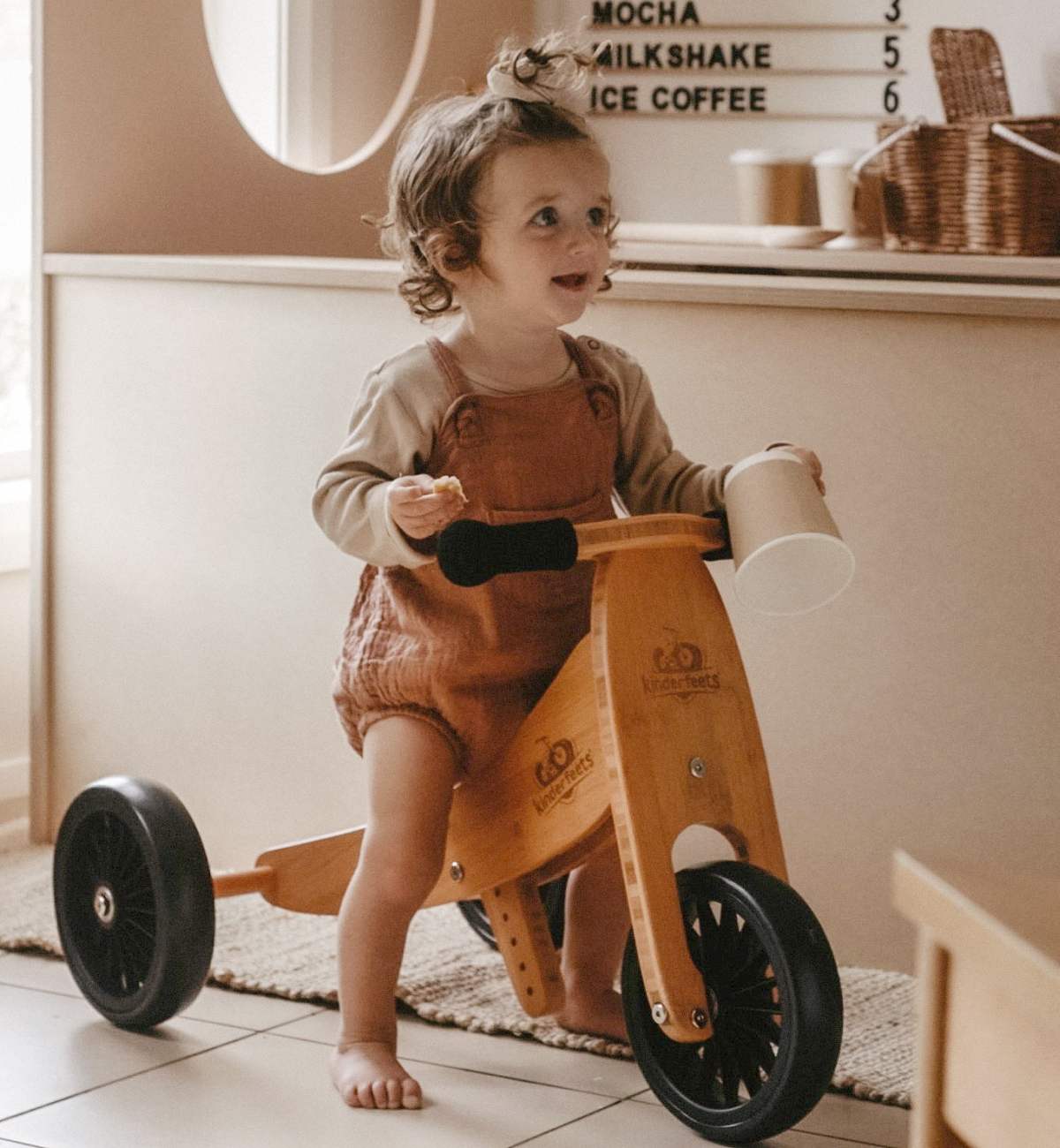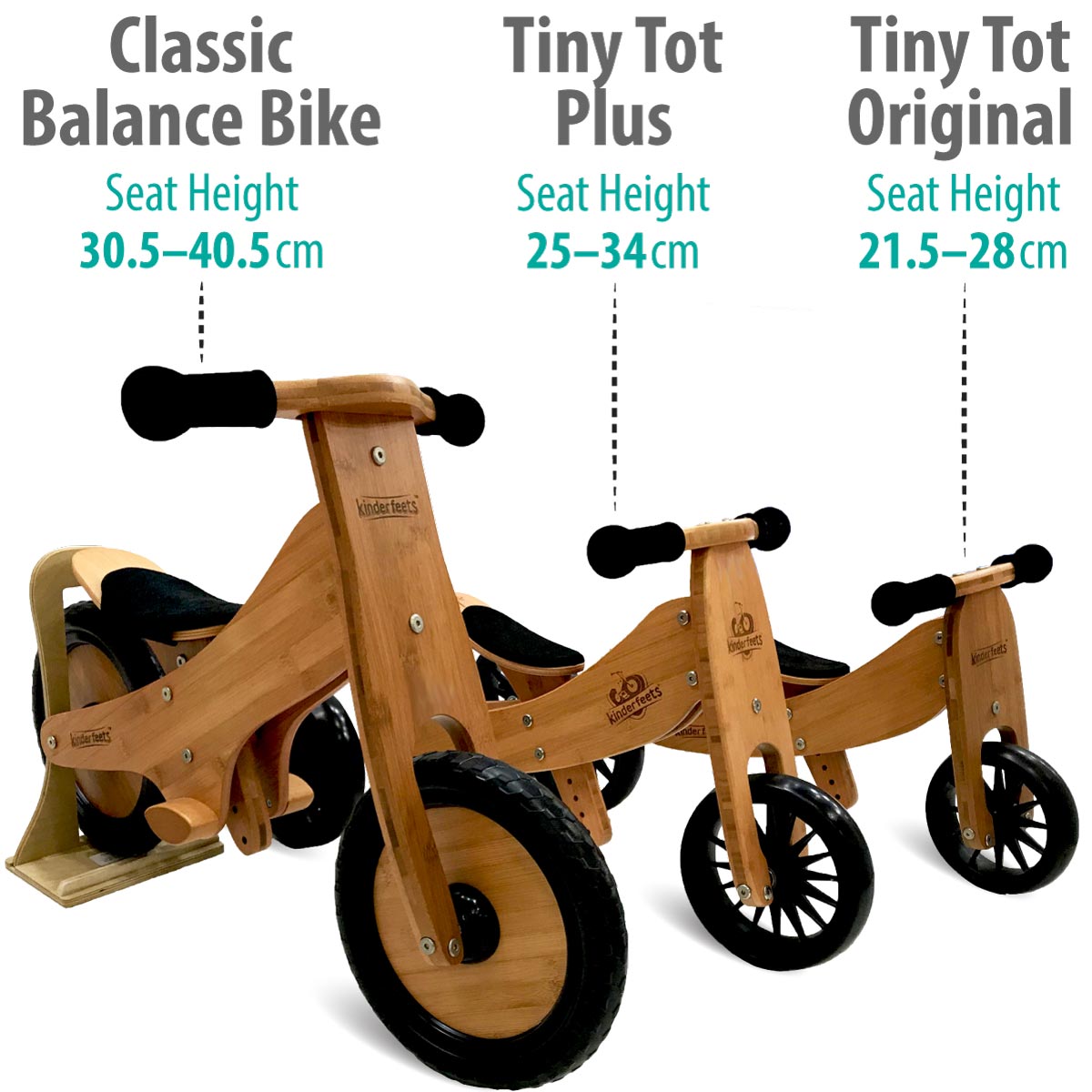Balance Bike & Trike Comparison Guide


Which bike is best for my child?
So you're on the hunt for the best balance bike or trike for your young one but aren't sure which one to choose? Here's a handy guide to help you find the right bike and teach your child to ride it safely.
Kinderfeets offers three different sized balance bikes for meeting a child's needs as they develop their balance and coordination skills. The right model for your child ultimately depends on their size, fine motor skills and balance coordination. Some children can take a little longer to develop these skills, or be of above or below average height.
Every Kinderfeets bike and trike is designed to keep pace with your child as they grow. The seat height can be adjusted on all bikes and trikes. Its trikes also include a conversion axle that transforms them into a balance bike.
Three models. Three different needs.
Original Tiny Tot
This is an entry level model. Its smaller frame is best suited for one to two-year-olds. It's ideal for children who've just learned to walk or stand. They love the additional freedom and mobility that a trike provides.
Tiny Tot Plus
The larger-sized Tiny Tot Plus caters for children aged 18 months to four years. However, don't be tempted to choose it thinking you'll get more use out of it. If your child is too small, or is still developing their gross motor skills, they'll struggle to control this larger model. You'll then have to set it aside until they've grown into it.
Classic Balance Bike
This is a traditional balance bike suitable for children aged two to four years. It's seat height can also be extended using an optional extension saddle. This extends the seat's height to 50cm making it ideal for older children developing balance and coordination skills at a slower pace. An extension saddle cannot be used on a Tiny Tot trike.
Use the table below to identify the right model for your child.
We also recommend measuring the inside length of your child's leg and compare this with each bike's seat height range. Seat height is measured from the ground to the lower rim of the seat saddle. If their inside leg measurement exceeds a bike or trike's maximum seat height by more than 3-4cms they may be too big for it.
| MODEL | FUNCTION | TYPICAL AGE RANGE | WEIGHT CAPACITY | SEAT HEIGHT |
| Original Tiny Tot |
2-in-1 Trike & Balance Bike |
12-24 months |
18 kg | 21.5-28 cm |
| Tiny Tot Plus | 2-in-1 Trike & Balance Bike |
18 months 4 years |
25 kg | 25-34 cm |
| Classic Balance Bike |
Balance Bike Only |
2-4 years | 30 kg | 30.5-40.5 cm |
Your child should be able to comfortably place both feet flat on the ground when seated, with near-straight legs. This will allow them to propel the bicycle forward with the balls of their feet in a running motion and bring the bicycle to a stop with their feet firmly contacting the ground.
The seat height can be adjusted if your child's knees are too bent. Simply raise it to a higher setting until it looks right and is comfortable for your little rider.
See the image below for an example of the ideal seated position.

Should I buy a trike or a balance bike?
The original Tiny Tot and Tiny Tot Plus both offer two-in-one value. They convert from a trike to a balance bike whenever your little zoomer is ready. Every Tiny Tot comes with a conversion axle included in the box. We've shared some tips on this page about the right time for converting a trike to a balance bike.
The larger Kinderfeets Classic Balance bike comes with two wheel only. It can't be converted to a trike.
If your child has strong motor skills and good balance when moving at pace on their feet they may be ready to move straight onto a two-wheel balance bike. Motor control skills like jumping and rotating your body without stumbling are often good indicators of coordination skills required for riding a balance bike.
If you're unsure about your child's development, it's best to start with a convertible trike. Use the size guide above to identify the right model.
My child is struggling to ride their Tiny Tot trike
Some children may struggle initially to ride a Kinderfeets Tiny Tot in stable manner. For example, their feet may hit the rear axle as they try to move it, or they struggle to steer it without toppling over. A range of contributing factors may be involved, none of which reflect an issue with the product's design.
Here are three common reasons why a child may struggle to master the art of trike riding - and some tips on how to help them.
Pace your child’s development
Children that are still developing their gross motor control, or seated balance, may struggle to push firmly downwards with their legs when using a Tiny Tot for the first time. They’ll often default to pushing backwards as this is an easier movement to make. However, the problem quickly sorts itself out as a child’s muscles strengthen and become conditioned. A Tiny Tot is ideal for developing these motor skills.
You can also encourage the development of these motor skills by practising downward movements on a gentle upwards slope. The slope will encourage your child to move their feet further forward to manoeuvre their trike.
How do you know if your child has developed the appropriate motor skills? Watch to see if they’re pushing down on the balls of their feet or using a flatter foot. Pushing on the tips of their toes is good indicator that your child is developing enough muscle control to refine their leg movements.
If these tips don’t resolve the problem, Kinderfeets recommends keeping your child off the trike for a month or two until these skills are developed
Adjust the seat height
The trike’s seat height may need to be raised. If the seat is set too low there's insufficient ground clearance for a child to push downwards and execute a proper running motion. They’ll then compensate by leaning forward and pushing backwards. This shifts their centre of gravity over the handlebars thus reducing the trike’s stability. All trikes are designed to be operated safely with the centre of gravity closer to the rear axle.
Adjust the seat height to encourage your child to push in downwards direction rather than backwards.
Transition to a balance bike
If the seat has been adjusted to its highest position, then your child may have almost outgrown the trike. This is often the right time to encourage them to start using a balance bike configuration.
It’s not unusual for children to initially resist this transition. However, with some encouragement and persistence children soon adapt and enjoy the experience. For some children this process takes a few weeks, for others they take a couple of months to gain the confidence and fine motor skills required to operate a balance bike.
For a real life experience, read Nicole Pate's story in the section below.
Lost your conversion axle?
You can purchase a range of Kinderfeets spare parts, including conversion axles, from Artiwood Australia. Click here for details.
When is it time to convert to a balance bike?
Nicole Pates, a Paediatric Physiotherapist in West Australia, shares her daughter's journey transitioning from trike to a balance bike.
My daughter was gifted a Kinderfeets Tiny Tot by her aunties on first birthday. At the time, she'd only been walking for about eight weeks.
Initially, she could only ride it backwards. However, after three months of consistent practice, about five mintues on our driveway most days (we left it in a visible spot for her to engage freely with it), she was riding it with ease.
She started to jump (an emerging balance and co-ordination skill) at about 16 months. The average is about 2-2.5 years. Professionally we expect by 3 years, although this depends on when they start walking.
At 18 months of age her heels consistently hit the rear wheel no matter how high we raised the seat. This experience, in conjunction with her new balance and motor skills, encouraged us to convert it to a balance bike. Kinderfeets says this is quite young for someone to make a transition but it ultimately worked for us.
However, let’s just say it didn’t go down well at first. She kept trying to put the third wheel back on. However, we kept persisting with little opportunities. Initially she'd only straddle it and walk along for a month or so.
After approximately 4 months of consistent practice, a couple of times a week, always led by her, and watching lots of older kids, as well as lots of experimenting, it just clicked and now she’s off and it’s wonderful to see.
Click here to watch Nicole's daughter getting the most out of her Kinderfeets Tiny Tot.

Always use a bike helmet
Teach your child to ride safely. Kinderfeets offers a range of helmets that feature an Adjustable Fit Dial System and additional comfort pads. They're suitable for heads with a circumference of 46 to 52cm.


